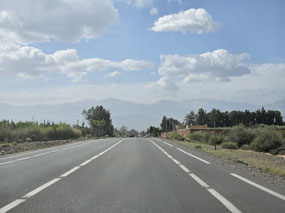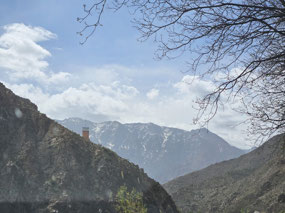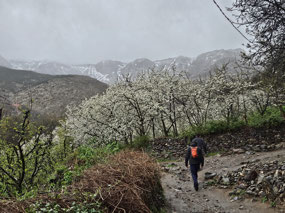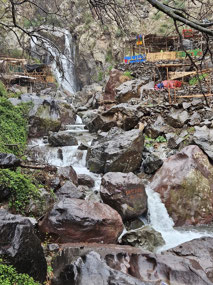Wednesday April 9, 2025
After a quick breakfast of cornflakes and fruit, we clean up our apartment and carry our luggage to the car. Our goal today is the High Atlas near Toubkal mountain.
Leaving Marrakesh is a little slow. There is morning traffic. The many roundabouts are slow and the air is dusty.
The road stays good as we leave the urban area and soon we are surrounded by agricultural fields. However, the land is dry and the most succesful crop is olive trees.
Some fields are very large, buy I see attempts at introducing the trees in dryer spots as well. Olive trees don’t need much water once they are established, and it would be very nice if something productive can be grown while at the same time fighting desertification.
Once, some 7000 years ago, during the African Humid Period, the Sahara was not a desert, but a humid green area. Numerous petroglyphes and analyses of human bones found in caves in the Sahara indicate that people ate rich diets. Elephants, giraffes and other large animals were common at that time.
If the desert could be turned green, much more heat can be absorbed, resulting in cooler circumstances. Maybe these areas can be a start.
In China much reforestation efforts have been conducted, and desertification has largely stopped there.
And as I think about these issues and we continue over the dusty roads, suddenly in the distance, high up, we see mountain tops with snow!
There it is, the High Atlas. One of the few areas in Africa where the mountains are snow covered. It’s like the Kilimanjaro and the Ruwenzori, places where my heart longs to go.
The road becomes very winding and follows valley walls. It mostly has asphalt but at some places there are deep holes.
The villages we pass have tourists - recognizable by their uniform outfits.
Finally we see a rusty sign indicating our lodge. We park the car beside the road and walk down concrete steps between stone buildings.
A fierce wind grips us and I am strongly reminded of Nepal when I look at the stoney landscape, the cluster of five or six stone houses, the path through the village that twists and turns, with stairs in many places because of the steep slope it’s built on.
We put the luggage in our room but shortly leave for a walk to a village nearby. A few drops start falling and soon a heavy rain comes over us. The rocky slope soon flows with water. We pass groves of walnut trees. All the agriculture is on very small terraces. We are in luck, because the cherry trees are blossoming, and large swaths of the cultivated terraces are like coated with snow.
When we reach the village we are soaking wet and warm up with hot mint tea in a little restaurant.
But the rain continues relentlessly, and finally we go out again to climb our way to a waterfall. All is wet and dripping. A few soaking tourists pass our way.
And when we finally reach our lodging again we are cold and wet. But happy.
After a while the water heater is repaired and we can take a shower. I didn’t have the patience so I showered cold, and now it’s waiting for dinner to be ready. Tagine!
Never had it before. Curious what it will taste like.
What a wonderful life I live. Al hamdoulillah.

 Dar Atlas Charme, Marrakech-Safi, Morocco
Dar Atlas Charme, Marrakech-Safi, Morocco





Joseph Heckman
2025-04-12
https://www.amazon.com/Saharasia-Origins-Sex-Repression-Warfare-Violence/dp/0980231647 Saharasia: The 4000 BCE Book to read about how that region turned into a dessert.
durieux
2025-04-14
Dear Joe. I read it. Amazing research. I very much enjoyed reading it, and I have recommended it to many people. Thanks for the link.